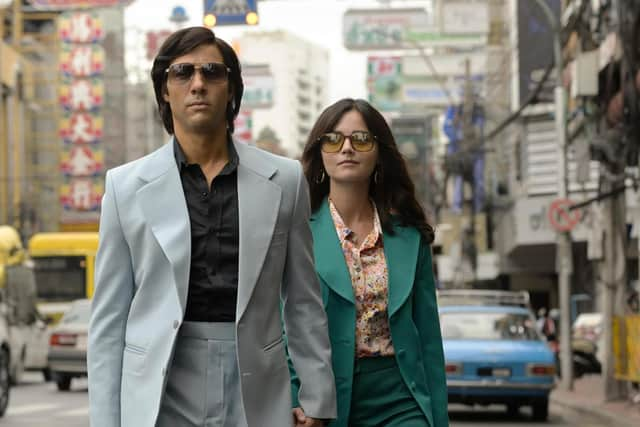Is The Serpent a true story? The truth behind the real Bikini Killer Charles Sobhraj, and where he is now
and live on Freeview channel 276
The BBC’s first big drama of the year – The Serpent – is captivating audiences with its outrageous tales of a pair of murderous con artists.
The central duo at the heart of the show’s crime-spree story are Tahar Rahim and Jenna Coleman, who play Charles Sobhraj and Marie-Andrée Leclerc respectively.
Advertisement
Hide AdAdvertisement
Hide AdIt’s another gripping true crime offering, but how much of it is a true story?


Here is everything you need to know.
What is The Serpent about?
According to the BBC, The Serpent tells the “remarkable” story of how “conman and murderer” Charles Sobhraj “was brought to justice.”


Travelling across the Indian subcontinent in the 1970s, and taking on false identities, the murderer and his girlfriend become the chief suspects in a series of murders of Western tourists.
"As the suspects repeatedly slip from the grasp of authorities around the world, Herman Knippenberg, a junior diplomat at the Dutch Embassy in Bangkok, unwittingly walks into their intricate web of crime.
Advertisement
Hide AdAdvertisement
Hide Ad“Knippenberg sets off an extraordinary chain of events that will see Sobhraj become Interpol’s most wanted man, with arrest warrants in multiple continents.”
Is The Serpent a true story?
The Serpent is indeed inspired by real events, and the story of French serial killer Charles Sobhraj and his girlfriend Marie-Andrée Leclerc is a true one.
During the mid-1970s, Sobhraj posed as a gem dealer, travelling across Thailand, Nepal and India, carrying out a spree of crimes on the Asian ‘Hippie Trail’ – the name given to an overland journey taken by members of the hippie subculture from the mid-1950s to the late 1970s between Europe and South Asia.
The trail passed through Iran, Afghanistan, Pakistan, India, and Nepal, and it was here that Sobhraj preyed on young Western travellers, who were often travelling as cheaply as possible to extend their time away from home.
Advertisement
Hide AdAdvertisement
Hide AdThe series takes its name from just one of Sobhraj’s nicknames; he was also known as the Bikini Killer due to the attire of his victims.
The number of murders Sobhraj and Leclerc committed is unknown, though they are believed to have claimed the lives of more than 12 victims, impressing and befriending tourists whom they then defrauded and killed.
What happened to Sobhraj?
Sobhraj was first captured in 1976 when an attempted murder went wrong.
He and his associates drugged a tour group of French students with poisoned pills, but when the drugs took effect quicker than anticipated, three of the students realised what Sobhraj had done and overpowered him before contacting the police.
Advertisement
Hide AdAdvertisement
Hide AdSobhraj was charged with murder and sent to a New Delhi prison to await trial. Despite his notoriety, he led a relatively comfortable life in confinement, having smuggled in precious gems with which he bribed his captors in exchange for luxuries.
concealed in his body and was experienced in bribing captors and living comfortably in jail. He turned his trial into a spectacle, hiring and firing lawyers at will, bringing in his recently paroled brother André to assist, and eventually going on a hunger strike. He was sentenced to 12 years in prison.
His ensuing trial saw Sobhraj gain infamy in the press, with his sporadic hiring and firing of lawyers and a much published hunger strike turning the process into a headline-grabbing spectacle. He was sentenced to 12 years in prison.
Did he escape prison?
Sobhraj’s time behind bars was not a usual one. His bribery of his guards became so rife that he was able to spend his days there in comfort, with television and meals of gourmet food, and he was even granted interviews to journalists and authors.
Advertisement
Hide AdAdvertisement
Hide AdHe would freely talk about his murders – while being careful to never actually admit – and claimed his actions were a retaliation against "Western imperialism" in Asia.
As Sobhraj’s sentence was due to end, he realised that a 20-year Thai arrest warrant against him would still be valid, which essentially ensured he would have been executed in the country.
So in his 10th year in custody, Sobhraj threw a party for his guards and fellow inmates, drugged them with sleeping pills and simply walked out of the jail.
He was quickly captured again, but with his prison term then extended by another decade, would avoid extradition to Thailand. His plan had worked.
Advertisement
Hide AdAdvertisement
Hide AdWhen he had served his time, he was allowed to walk free once more in 1997; by now most warrants, evidence and witnesses against him had been long lost to time, and the 52-year old was able to retire to France.
Where is he now?
Sobrahj was reprimanded again in 2003, when he was spotted gambling by a journalist in a casino in Kathmandu.
The journalist’s report alerted Nepalese authorities to Sobrahj’s whereabouts, and he was arrested in the casino while still gambling.
Reopening historic murder cases, the Nepalese were able to get Sobhraj sentenced to life imprisonment for crimes he committed in 1975.
Advertisement
Hide AdAdvertisement
Hide AdSobrahj has tried and failed multiple times to have his conviction overturned – including a rather elaborate plot to wed a Nepalese woman, which is disputed by the authorities – but remains in jail where he is serving a life sentence.
When can I watch The Serpent?
New episodes of The Serpent are broadcast at 9pm on Sunday evenings on BBC One.
Previous episodes in the series can be caught up on through iPlayer.

